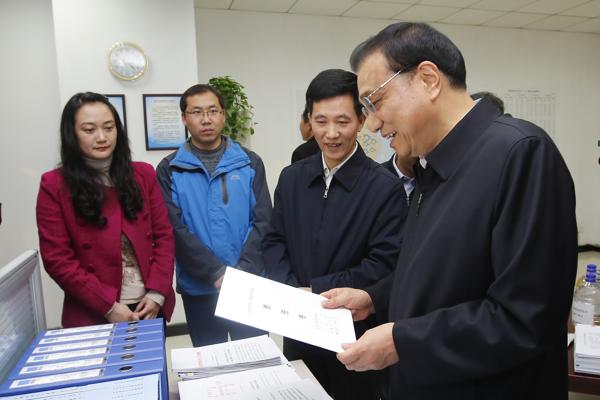
Premier Li Keqiang asks about the task of rural drinking water safety during his visit to the Ministry of Water Resources in Beijing, capital of China, Nov. 24. Li Keqiang made an inspection tour of the Ministry of Water Resources in Beijing on that day. [Photo by Zhang Duo/Xinhua]
The government is ready to green-light more water conservancy projects in the pipeline and speed up ongoing construction-major pro-growth investment policies to shore up economic expansion in 2015.
Public-private partnership financing as well as build-operate-transfer and transfer-operate-transfer financing, will be encouraged to introduce social capital in these projects.
Construction on 44 water conservancy projects is expected to start by the end of next year, totaling 252.8 billion yuan ($41.2 billion). Eighty-eight other water projects are to be researched and initiated by the end of 2020.
Of the 44 projects, 14 projects are already under construction, with a total investment of 38 billion yuan from the central government, and are expected to bring another 28.5 billion yuan of local funding when completed.
By 2020, China will build 172 water conservancy projects in the country, especially in areas with water shortages, irrigating more than 5.2 million hectares.
These projects are mostly water diversion projects that will quench the thirst with water from water-rich areas and improve the sanitary conditions of tap water in rural China.
Premier Li Keqiang, on a fact-finding visit to the Ministry of Water Resources on Nov 24, said water conservancy projects will be able to become the next investment hot spot, following railway and government-funded housing.
“It is an opportune moment to expedite major water projects now. The economy is declining, and so is investment. We need a key investment area to prop up the economy, and water conservancy will not raise concerns of redundant construction since it is an important public good to improve livelihood,” Li said.
China’s economy expanded by 7.3 percent in the third quarter this year, the lowest rate in five years, and many economists have forecast an even lower rate of growth in 2015.
On Nov 24, Li urged water conservancy officials to hasten the approval of new projects and ongoing construction, stressing that they should undertake funding reform to introduce private investors in these construction projects through public-private partnership, build-operate-transfer and transfer-operate-transfer financing.
Wang Aiguo, an official from the ministry in charge of rural drinking water safety, said private capital is reluctant to invest in water projects since these projects require a lot of money and are less profitable.
He said the investments to improve the sanitary conditions of rural drinking water, about 35.7 billion yuan this year, are mostly from the central and local governments.
“At some places, residents are able to raise some money, but usually not much,” Wang said.
Projects made to ensure the access of safe tap water will benefit a total of 62 million rural people this year.
